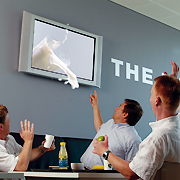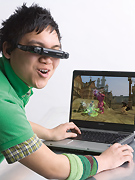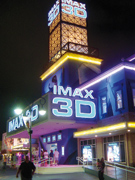|
Looking at 3D television from every angle
A new Study Question is being examined in ITU–R
 Philips
Philips
3D television will provide
a new type of viewing experience
|
A new topic of study has been agreed for ITU — digital three-dimensional, or 3D, television. It is part of the work of Study Group 6 of ITU’s Radiocommunication Sector (ITU–R), and the goal is to achieve a worldwide standard for this advance in broadcasting.

Vuzix As well as its application in television and the cinema, 3D viewing technology is being used by players of video games through head-mounted displays, giving a fully immersive experience that is like being in the real world
|
3D television is a general name for broadcasts that provide viewers with a sense of depth similar to what is experienced in real life. Each eye sees the world from a slightly different angle, and the brain merges these two inputs to create a central single image that has depth. This has been understood for more than 100 years, and several techniques have been developed for recreating the effect in still photographs and movies. For example, a film is shot from two different angles, and each of the viewer’s eyes is presented with the image from one of those angles. This is called stereoscopy, and has featured in Hollywood movies.
Although this concept of 3D vision is simple to understand, it is difficult to achieve a technique that does not cause eye fatigue after a certain time. Most higher resolution systems need to be viewed through special eyeglasses, which can be uncomfortable. Digital alignment of their lenses can help to reduce eye fatigue, but is not the complete answer.
In addition, the 3D systems developed so far can only be seen properly from a limited range of positions. This problem could be overcome by “free viewpoint television” (FTV) systems that mean viewers can sit anywhere to enjoy the picture. These allow people to set their preferred viewpoint and change it continuously in a range determined by the number of cameras used to film a scene, and their allocation. In the longer term, it is possible that new forms of “object wave recording” could be developed that permit 3D television images to be presented on new types of holographic display.
Among the countries where 3D research has been carried out for many years are Canada, China, France, Germany, Italy, Japan, the Russian Federation, the United Kingdom and the United States. The Russian Federation made the proposal to ITU–R that the time was ripe for worldwide agreements to be created on 3D television. The resulting Study Question comes under Working Party 6C of ITU–R Study Group 6. It is calling for contributions from the ITU membership on 3D systems that include — but also go beyond — stereoscopy.

Chris Metcalf
Modern versions of 3D films are proving popular at the cinema
|
Digital 3D television broadcasting will be able to convey to the viewer a much greater sense of “being there” in the scene. The dawn of the technology will bring a new type of entertainment to the home. Pooling ideas at this early stage gives the best chance of developing a single, worldwide standard. The work of ITU in this field could have a profound impact on the experience of viewers in the years to come.
|
The Study Group invites contributions
on 3D television for its next meeting on 20–24 October 2008,
(to be received by 13 October).
For more information, contact ITU–R by
e-mail at
rsg6@itu.int. |
|


